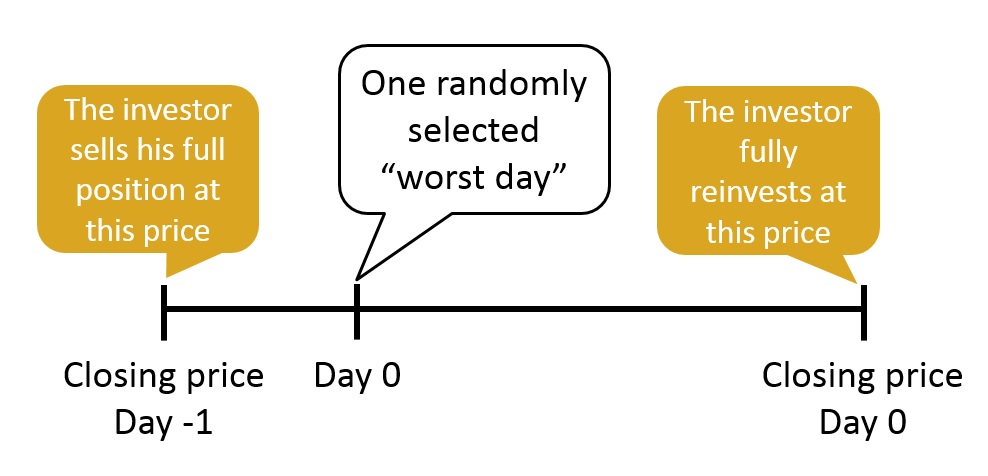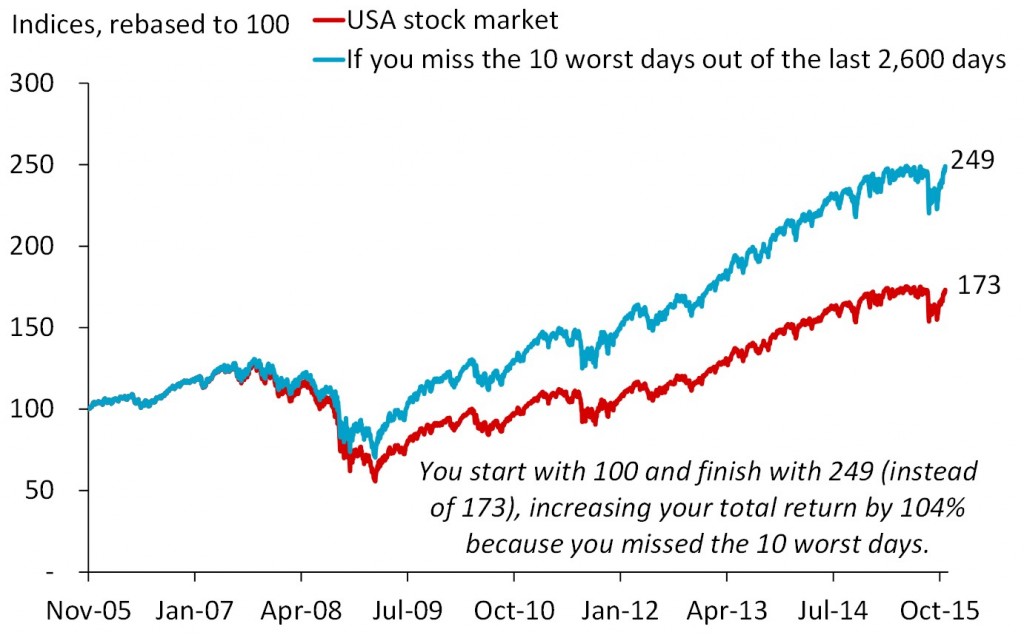Avoiding The 10 Worst Days Increases Your Return Massively
Watch the video with Andrew Stotz or read the research below.
Previously, we put out a piece on The 10 Best Days—meaning, what would be the return or what would be the loss if we missed The 10 Best Days?
We got a lot of comments from people saying they read it, they liked it, it was helpful; we also started to get some questions about whether we could take a closer look at what would happen if we missed The 10 Worst Days as opposed to the 10 Best?
Seeing a lot of feedback on this, we decided to expand this research from The 10 Best Days and the Clustering of Best and Worst Days.
What we want to do is look into this particular question about missing The 10 Worst Days.
We’re going to use our academic-style research format which is to ask a question first; then review prior research to understand what we know; formulate a hypothesis that we’re going to test; then select our data set (in this case, we’re going to look at the US, but we’re going to look at others over time); and also consider our method of how we’re going to do our calculations; review the results; and, most importantly, for the benefit of all of us, how do we apply our findings to make better investment decisions or become better investors.
Question
So, what was the question that we wanted to ask?
What impact would missing The 10 Worst Days in a 10-year period have on terminal wealth?
Review
We reviewed the research that’s been done on this in The 10 Best Days, and this is what we found in that research about The 10 Worst days.
In 2004, Johnson & Krueger found that avoiding the 10 worst days between 1982-2001 would have enhanced your returns by 39%, and missing both the best and worst days would have increased annual returns by 15%.
In 2009, Estrada said missing the 10 worst days in the Dow Jones Industrial Average from 1900-2006 would have resulted in a 206% higher portfolio value compared to a passive buy-and-hold strategy.
Well, it would be great if we could say that we could miss those 10 worst days, but it’s highly unlikely.
Estrada also said that by missing The 10 Worst Days in emerging markets, you got even better returns than in developed markets; this is because the volatility of emerging markets is much higher.
Hypothesis
Let’s look at our hypothesis: Missing The 10 Worst Days would significantly increase terminal wealth over a 10-year investment horizon.
Data
Our data set: We gathered the U.S. market time-series data in for the past 10 years. Then, we calculated the percent change of each day and identified the 100 worst daily return days.
Method
We invested in the market but removed 10 randomly selected days out of the 100 worst days.
Now, this is where our research differs from some of the others where we would say, “What would be the probability that you would miss either The 10 Best or The 10 Worst Days?”
It’s very unlikely that you would be so unlucky or so lucky. Therefore, we’re going to randomly select our subsets of the 10 Best Days and the 10 Worst Days out of the total sets of 100 best days and 100 worst days, in order to be more realistic.
We’re going to assume a zero percent return on those 10 days, and we’re going to repeat this process a hundred times to look at average, maximum, and minimum terminal wealth.
What we really care about is the average.
Imagine that at Day Zero, you have a worst day. The investor sells his full position at the closing price of the prior day and they reinvest at the closing price at Day Zero. So they’re out for the whole of Day Zero.
Results
Let’s review our prior research on The 10 Best Days, and what you can see from this is that the market had a long-term return, a terminal value that went from 100 over 10 years up to 173.
But if you missed The 10 Best Days, you would have only gotten a return of 125. Basically, you would have lost 66% of your total return because of missing those 10 Best Days.
Let’s remind ourselves that the market had a terminal value of 173. Now, we’re going to switch to The 10 Worst Days and the findings from our research.
We can see that the 173 is still there.
What happened was that if you missed The 10 Worst Days, you would have earned a return of 249 in your terminal value—meaning, you’ve increased your total return by slightly over 100% by being out of the market for The 10 Worst Days.
We can see a distribution of the terminal value results attained using our random subsets of 10 Worst Days. You could have gained as much as 200%, tripling your principal. But we want to look at the average.
Action
Now, the action: What we can learn is that missing only The 10 Worst Days during a 10-year period increases your terminal wealth significantly. On average, you gain 100% more compared to buy-and-hold.
This impact on return is even greater than that of missing The 10 Best Days. What we mean by that is that The 10 Worst Days are more painful than The 10 Best Days are successful.
And that’s interesting to think about alongside Daniel Kahneman’s work regarding how, emotionally, a loss is so much more painful than a gain is enjoyable.
Well, it’s also just more painful because of the fact that the market falls so dramatically.
If you can perfectly time the market on best or worst days, well, great and good for you to do it. And you’d certainly want to be out of those 10 worst days.
Unfortunately, that’s a darn hard thing to do.
So what we would think is that, for the average investor, it makes sense to stay invested over that time unless you’ve got some strategy that can get you out of The 10 Worst Days because you are going to really perform.
Action in summary
- Avoiding The 10 Worst Days during a 10-year period increases your terminal wealth significantly
- On average, you gain 104% more compared to buy-and-hold, but could gain as much as 200% more
- This impact on return is even greater than that of missing The 10 Best Days, hence The 10 Worst Days are more painful than The 10 Best Days are enjoyable
- If you can perfectly time the market on best or worst days, well, great – do it!
- Unfortunately, that’s a darn hard thing to do. For the average investor, it makes sense to stay invested
Learn more about how likely it is that an investor would actually miss The 10 Best Days, in our post: Clustering of Best and Worst Days or what impact missing The 10 Best days has on your terminal wealth.
Do you buy and hold or do you try to time the market? We’d love to hear from you in a comment below.
Feel free to share this article with your friends.
DISCLAIMER: This content is for information purposes only. It is not intended to be investment advice. Readers should not consider statements made by the author(s) as formal recommendations and should consult their financial advisor before making any investment decisions. While the information provided is believed to be accurate, it may include errors or inaccuracies. The author(s) cannot be held liable for any actions taken as a result of reading this article.




